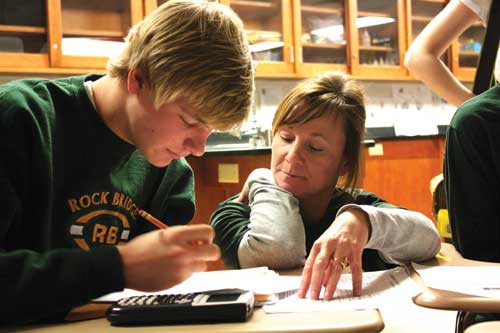For years, there has been a gap between student-to-teacher ratios within Columbia Public Schools’ (CPS) high schools. Recently, CPS began trying to address this ratio gap, CPS Community Relations Director Michelle Baumstark said.
Full-time equivalent (FTE) units are the number of equivalent employees working full-time. While unsure of the exact impact the additional FTE will have on the student-to-teacher ratio, RBHS principal Dr. Jennifer Rukstad says the FTE will be dispersed among RBHS departments.
“At this time, we have been promised at least 2.0 FTE, which equates to 10 sections,” Dr. Rukstad said. “Those sections will be distributed based on a variety of factors and not equally across the board. If we get more [FTE], we will distribute more. We have yet to decide exactly where the additional FTE goes.”
The student-to-teacher ratio helps express the relationship between the number of students enrolled and the number of FTE teachers employed by the school. The student-to-teacher ratio is relevant for a variety of reasons, measuring both teacher workload and distribution of resources, according to Public School Review. The student-to-teacher ratio also indicates the amount of individual attention students are likely to receive, despite the fact all classes are different sizes. If the student-to-teacher ratio at a school is low, it should be an indicator that students are getting the appropriate level of attention needed to be successful. The report also states when the ratio is high, however, it acts as a warning that students may not receive the same level of individual support.

Even before the opening of Battle High School (BHS) in 2014, both RBHS and Hickman High School (HHS) have had different student-to-teacher ratios, the ratio consistently being higher at RBHS than HHS. RBHS continues to have the highest student-to-teacher ratio, being reported at 18:1, compared to both HHS and BHS which both have 14:1, according to the Missouri Department of Elementary and Secondary Education, as of March 7.
Although there isn’t a large difference between the three ratios, RBHS’s 18:1 is higher than both the 14:1 Missouri average and 16:1 national average, according to Ballotpedia.
For Baumstark, the discrepancy between schools is normal and multiple factors may influence the ratio disparity throughout the district.
“This could be for a number of reasons, including specific course offerings and enrollments in those classes, special education requirements and specialized programs offered to support students and how FTE are allocated within the building,” Baumstark said. “Additionally, flexible student scheduling also comes into play. High school doesn’t look the same as it used to as we continue to offer more and more opportunities for our students outside of a traditional school day.”
CPS students such as sophomore Jack Stevens expect the ratios to be the same among RBHS, HHS and BHS but isn’t taken aback by the fact that those ratios change and are in fact, different. Stevens believes each school has different needs, resulting in some schools having more teachers and a lower student to teacher ratio than other schools within the district.
“I would expect all student to teacher ratios to be the same at CPS, but each school has different needs, and CPS and the administration at each school know how to address and handle those issues,” Stevens said. “More teachers might be needed at one school than another, so I’m not surprised that each school has different ratios and amounts of teachers because each school has its own separate needs.”
Despite the higher ratio RBHS possesses, students such as Stevens see little to no overcrowding in class or in general at RBHS. Additionally, while Stevens opposes the idea of getting rid of teachers at RBHS, he doesn’t feel there is a necessity for more teachers in social studies, English or science classes. Instead, he sees the need for a larger teaching staff in both elective and mathematics courses so that despite low course enrollment, every student has the opportunity to learn and get help from knowledgeable teachers.
“I personally believe that Rock Bridge has a very good amount of teachers. I do not wish to have less,” Stevens said. “[I think we need more teachers for] world languages because I wasn’t too happy [with] the issue of having to get rid of some languages. I feel like some teachers always have guaranteed jobs, while some language teachers have to hope to have enough students for their class next year. I also wish to have more math teachers because in the math tutor room I hear of friends not being able to get help because the teacher in the tutor room doesn’t know [how to do the math for every course].”
Dr. Rukstad is in opposition to Stevens, believing that overloading certain courses with a large number of students can have negative effects on both students and teachers, which is ultimately why enrollment, either high or low, determines the number of teachers needed each school year.
“Enrollment is definitely a factor in determining the number of teachers,” Dr. Rukstad said. “[With high student-to-teacher ratios] opportunity for individual attention during class is diminished.”
Ultimately, despite the additional FTE to RBHS in upcoming years, Baumstark believes the experience and expertise of teachers and staff is the most important factor when it comes to a student’s education.
“The most important component when it comes to staffing is quality,” Baumstark said. “A good, high quality teacher makes all the difference. You could have a class of one, but if the instructor isn’t high quality it doesn’t matter.”
Categories:
Teacher staffing ratios different in CPS high schools
March 30, 2018

0
More to Discover












































































